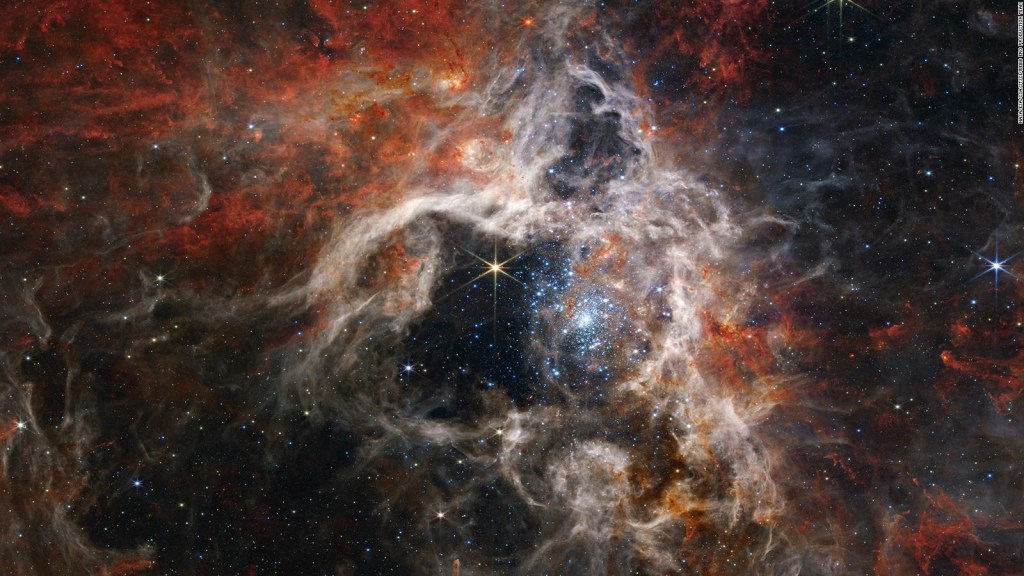The Webb Telescope captures a rare postcard of the Tarantula Nebula 0:35
(CNN) --
NASA's Webb Space Telescope captured a giant space tarantula thanks to its high sensitivity.
161,000 light-years from Earth, in the Large Magellanic Cloud galaxy, is the Tarantula Nebula, as 30 Doradus is called, the "largest and brightest star-forming region of the Local Group, the brightest galaxies". close to our Milky Way," according to NASA's Jet Propulsion Laboratory.
The nebula looks like the burrow of a burrowing tarantula with its web, and is home to the hottest and most massive stars known to astronomers, according to NASA.
The Webb Telescope's Near Infrared Camera, also called NIRCam, has helped researchers see the region "in a new light, including tens of thousands of never-before-seen young stars that were previously shrouded in cosmic dust," according to NASA. .
The denser surrounding areas of the nebula resist erosion by the stars' strong winds, forming pillars that appear to point into the cluster and support the forming protostars.
In this mosaic image spanning 340 light-years, Webb's Near Infrared Camera (NIRCam) shows the star-forming region of the Tarantula Nebula in a new light.
These protostars emerge from their "dusty cocoons" and help shape the nebula.
The Webb Telescope's Near-Infrared Spectrograph (NIRSpec) caught a very young star doing just that, changing astronomers' previous beliefs about the star.
advertising
"Astronomers previously thought that this star might be a little older and already in the process of removing a bubble around it," according to NASA.
"However, NIRSpec showed that the star was just beginning to emerge from its pillar and still had an insulating cloud of dust around it."
"Without Webb's high-resolution spectra at infrared wavelengths, this star-forming episode in action could not have been revealed."
Viewing through another Webb instrument that detects longer infrared wavelengths, and thus penetrates the nebula's dust grains, revealed a "never-before-seen cosmic environment," NASA said: hot stars they vanished as cooler gas and dust glowed.
Webb vs.
Hubble.
Look at the contrasts between the images of nebulae captured by NASA telescopes before and now
The Tarantula Nebula has long been the focus of astronomers studying star formation because it has a chemical composition similar to that of the giant star-forming regions at cosmic noon in the universe, when the cosmos was barely a thousand years old. million years and star formation was at its peak, according to NASA.
Since the star-forming regions of our galaxy do not produce stars at the same rate as the Tarantula Nebula and have a different chemical composition, the Tarantula is the closest example of what happened in the universe at cosmic noon.
Capturing star formation in the Tarantula Nebula is just the latest discovery from NASA's Webb Telescope.
Just a few days ago, NASA released stunning new images produced by the Webb Telescope and the Hubble Telescope showing the Ghost Galaxy, a spiral of solar systems 32 million light-years from Earth.
The galaxy is located in the constellation of Pisces, according to the European Space Agency, which collaborates with NASA on Hubble and Webb.
Webb takes incredible photos of the heart of the Ghost Galaxy 0:58
The Webb telescope was launched on Christmas Day last year after decades of work to create the world's largest and most sophisticated space telescope.
NASA released the first high-resolution images of Webb just weeks ago, in July.
The telescope, larger than Hubble, is capable of observing extremely distant galaxies, allowing scientists to learn about early star formation.
Hubble orbits the Earth, but Webb orbits the Sun, almost two million kilometers from Earth.
InstaNewsNebulaWebb Telescope






